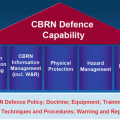18.3 Regulatory Oversight
Evaluations of the Fukushima accident have raised questions about regulatory oversight [1, 3, 7]. A study commissioned by the Japanese national legislature, for example, attributed a lax safety environment preceding the accident to a flawed safety culture and lack of regulator autonomy [3]. A 2013 meeting of national nuclear safety regulators from more than 50 countries articulated broader conclusions, recommending that nuclear safety regulators should utilize the International Atomic Energy Agency’s (IAEA) peer review process as early as possible; and that peer reviews must include national action plans and follow-up missions [8, 9].
To clarify, engagement with the IAEA for its Integrated Regulatory Review Service (IRRS) currently serves as one of the more widely recognized forms of peer review to evaluate strengths and weaknesses of national regulatory entities, including organizational independence. IRRS assessments can be a useful tool, but must be recognized for their limitations to a nuclear safety regime. Reviews are done on a voluntary basis and follow-up assessments may not be completed. Reviewers also vary and, as with any subjective assessments, determinations are subject to interpretation.2 Among the six countries of this study, all have undergone the IRRS process, except India, which will do so in 2015. France, Russia and the US – some of the more traditional nuclear states – have been evaluated prior to and following the accident at Fukushima [11] (Table 18.1).
Table 18.1
IAEA reviews: Integrated Regulatory Reviews Service (IRRS)
China | France | India | S. Korea | Russia | US | |
|---|---|---|---|---|---|---|
Pre-Fukushima | 1 | 2 | 0 | 0 | 1 | 1 |
Post-Fukushima | 0 | 1 | 0 | 1 | 1 | 1 |
Planned | 1 | 1 |
Functioning somewhat differently, from IRRS assessments the Convention on Nuclear Safety (CNS) requires contracting countries to agree to safety obligations and peer reporting review. This multilateral treaty, created in 1994 and now with 77 contracting parties, obliges member states to ensure that a regulatory framework is in place alongside a regulatory entity that has adequate authority, resources, and competence to oversee nuclear safety [12]. Member states must assure effective separation between safety oversight and industry promotion as well as other interests [7]. Since the Fukushima accident, there have been two review meetings and one extraordinary meeting in which contracting parties have reported on treaty obligations and discussed ways to improve nuclear safety worldwide. All six countries of this study are parties to the CNS and have participated in some manner. Like the IRRS process, CNS engagement serves a purpose, yet has limits on the extent of peer review.
18.3.1 Country Specifics
Engagement in IRRS and CNS reviews offers some indication of state-level commitments to nuclear safety, yet closer inspection of national regulatory bodies and related rules will provide greater depth on country specifics.
China
The Chinese nuclear regulator, National Nuclear Safety Administration (NNSA), has not been significantly restructured following the Fukushima accident. However, the accident underscored the importance of the agency. Additional financial and personnel resources have been made available. A mixed picture exists in terms of regulatory independence.
The current NNSA in China was established in 2008, superseding its predecessor as the regulator of nuclear and radiation safety, and radiological environment management [13].3 This agency acts as an administrative subordinate to the Ministry of Environmental Protection (MEP). In line with this, a 2010 IRRS review found that the NNSA “lacks some flexibility, within the policies and procedures of the government, to be competitive for recruiting experienced staff.” However, specific to independence of the NNSA, the review did not find any issue “that could potentially put undue influence on its regulatory decision-making [13].” Other observers have, however, questioned the NNSA’s autonomy. As a subordinate of the MEP, the NNSA is administratively positioned in the state apparatus beneath the state-owned NPPs which it oversees [14]. The NNSA also does not have its own R&D team to evaluate reactor designs for acquired technology (Ibid, citing personal communications). In 2011, the Chinese State Council Research Office recommended restructuring in such a way that the NNSA would be directly under the State Council Bureau, making it an independent regulatory body with greater authority [15].
Looking beyond the NNSA’s organizational structure, China has been working in other ways to strengthen nuclear safety. Following the Fukushima accident, the pace of China’s rapidly growing nuclear program was halted as a precaution to fortify its regulatory authority [7]. In line with this, licensing of new reactors was suspended in 2011 until the NNSA was improved, and until safety inspections were completed (Ibid). The Chinese government also consented to a budget increase for the NNSA and to a near doubling of its staff (Ibid). The 12th Five Year Plan recommended investment of nearly 80 billion RMB ($13 billion) by 2015 to enhance safety of NPPs, as robust growth occurs with different reactor technologies and designs, and safety standards ([16], citing 12th FYP).
Going further, little is broadly known about the appointment and removal processes of Chinese nuclear safety regulators. Currently, China does not have an atomic energy law, governing the use of the energy and associated activity. Such legislation has been under consideration since the 1980s and a draft is reportedly underway [16].
France
The French nuclear safety agency, Autorité de sûreté nucléaire (ASN), underwent notable change prior to the Fukushima accident. The shift is consistent with the lessons of independence tied to the accident.
France established the ASN, an independent administrative authority on nuclear safety, with the Act on Transparency and Security (no 2006 686, June 13, 2006) (TSN). The ASN is comprised of a board of five Commissioners which reports to Parliament. Commissioners are appointed for a non-renewable 6 year term and are not dismissible [17]. Following the establishment of the ASN, an IRRS was completed in 2006 with a subsequent review completed in 2009 at the request of the French government. In terms of agency independence, the 2006 review indicated: “In order to fully clarify and enhance its independent status, and put into place the new enforcement powers, ASN should as soon as practicable fully implement the requirements and powers given to it by the new TSN 2006 Act through elaboration and implementation of the necessary Decrees and Orders [18].” The subsequent review in 2009 found that the ASN had made significant progress in the implementation of requirements and powers granted to it in the 2006 Act. An IRRS in November 2014 may confirm this.
Changes in French nuclear safety rules appear to be limited post-Fukushima, in part since many safety improvements were introduced following a nuclear incident in France in 1999 [7].4 The NPP operator is also partly state-owned, so formal regulation may not be required in the same way as with privately owned plants.
India
India’s nuclear regulator, by many accounts, is not an autonomous body. Calls for restructuring were made prior to and after the accident at Fukushima. A proposal to restructure has been open at least since 2011.
Established in 1983, the Indian Atomic Energy Regulatory Board (AERB) is a governmental board that reports to the Atomic Energy Commission where the utilization of nuclear energy is promoted. The AERB has been the subject of regulatory questions for quite some time. A Committee report in 1997 called for a revision to the Atomic Energy Act to improve regulatory efficacy [19]. In 2011, Parliament introduced a bill to create a new regulatory agency with continued questions about autonomy. In 2012, the Comptroller and Auditor General released a report, noting the lack of independence by the AERB, and findings that 60 % of regulatory inspections of operating NPPs were either delayed up to 153 days or not completed [20]. Smaller radiation facilities were also said to operate without rules or oversight (Ibid). In December 2013, a bi-partisan Public Accounts Committee Report described the AERB as “weak, under-resourced, and ‘slow in adopting international benchmarks and good practices in the areas of nuclear and radiation and operation’ (Ibid).” The report also noted that the AERB could not set or enforce rules for nuclear or radiation safety, and in many instances rules do not exist. The timeline for creating a new regulator remains to be seen a recent CNS report by India indicates that a bill to establish a new nuclear safety regulator is undergoing a final round of approval [21].
The current Chairman of the AERB, a former senior executive director of the nuclear power utility, noted in 2013 that AERB processes were evolving and challenged by the growth in new projects of diverse designs, a fast growing program, and operation in a competitive environment [22].
In July of 2014, rules relating to atomic energy were consolidated [23]. India’s first IRRS is scheduled for 2015. The lack of separation between the AERB and the agency responsible for promoting the industry has been raised as a violation of the CNS [24]
Russia
Russia’s nuclear safety regulator, Rostechnadzor, reports to the government and not to a specific ministry. A notable change occurred in its independence prior to the Fukushima accident. A Post-Fukushima review of the NPP fleet by the regulator and related team showed that the regulatory framework governing nuclear and radiological activity required revision for severe accident conditions and their prevention.
The Federal Environmental, Industrial and Nuclear Supervision Service of Russia – Rostechnadzor – is an executive body that reports directly to the Government of the Russian Federation. Its current structure was revised in 2010, moving it from a formerly subordinate position, reporting to the Ministry of Natural Resources and the Environment. The autonomy of Rostechnadzor, according to a recent IRRS, is now “effectively independent of other federal executive authorities” with the removal of restrictions on its inspections [25]. Specific to appointments, a 2009 IRRS noted that the head of Rostechnadzor was appointed by the Prime Minister, and can be dismissed similarly. Decisions of Rostechnadzor could also be overturned by a court of law [26]. It is unclear if these organizational features were changed with the organizational revisions in 2010.
In terms of oversight activity, the 2013 IRRS indicated that the adequacy of human and financial resources reflected progress since 2009. However, more would be required to ensure the competency of the regulator [25]. Currently, the staff of Rostechnadzor relies on external entities for technical review and assessment of applications for approval. In line with aims to enhance the agency’s capacity, a comprehensive management system is being implemented, and must advance in order to sufficiently support the now independent regulator (Ibid).
Stay updated, free articles. Join our Telegram channel

Full access? Get Clinical Tree







